MGMT20132: Innovation & Sustainable Business Development Report
VerifiedAdded on 2023/06/11
|16
|3878
|369
Report
AI Summary
This report explores the innovative approach of Burger Urge, an Australian burger restaurant chain, to achieve sustainable business development through drone-based delivery. Facing stiff competition, Burger Urge aims to differentiate itself by partnering with Skymax to offer faster delivery times, reduce reliance on human delivery personnel, and mitigate issues related to traffic delays and customer interactions. The report evaluates the business model canvas, highlighting key partners, activities, value propositions, and cost structure. It addresses the problems that drone delivery can solve, such as reducing waiting times and environmental impact, while also outlining a strategic plan for implementation, including SWOT analysis and project option analysis. The recommended solution emphasizes the feasibility and competitive advantages of drone delivery in enhancing customer satisfaction and brand loyalty.
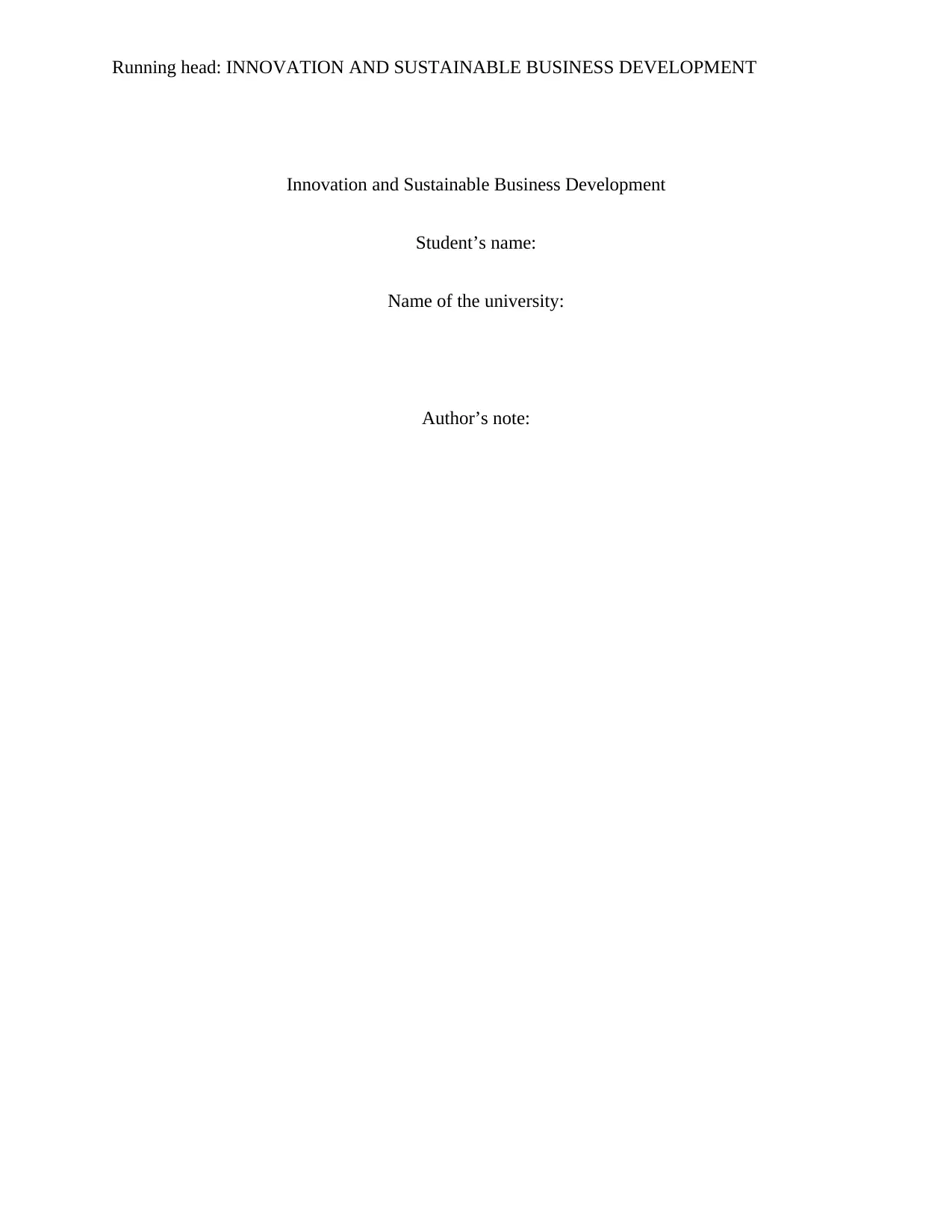
Running head: INNOVATION AND SUSTAINABLE BUSINESS DEVELOPMENT
Innovation and Sustainable Business Development
Student’s name:
Name of the university:
Author’s note:
Innovation and Sustainable Business Development
Student’s name:
Name of the university:
Author’s note:
Paraphrase This Document
Need a fresh take? Get an instant paraphrase of this document with our AI Paraphraser
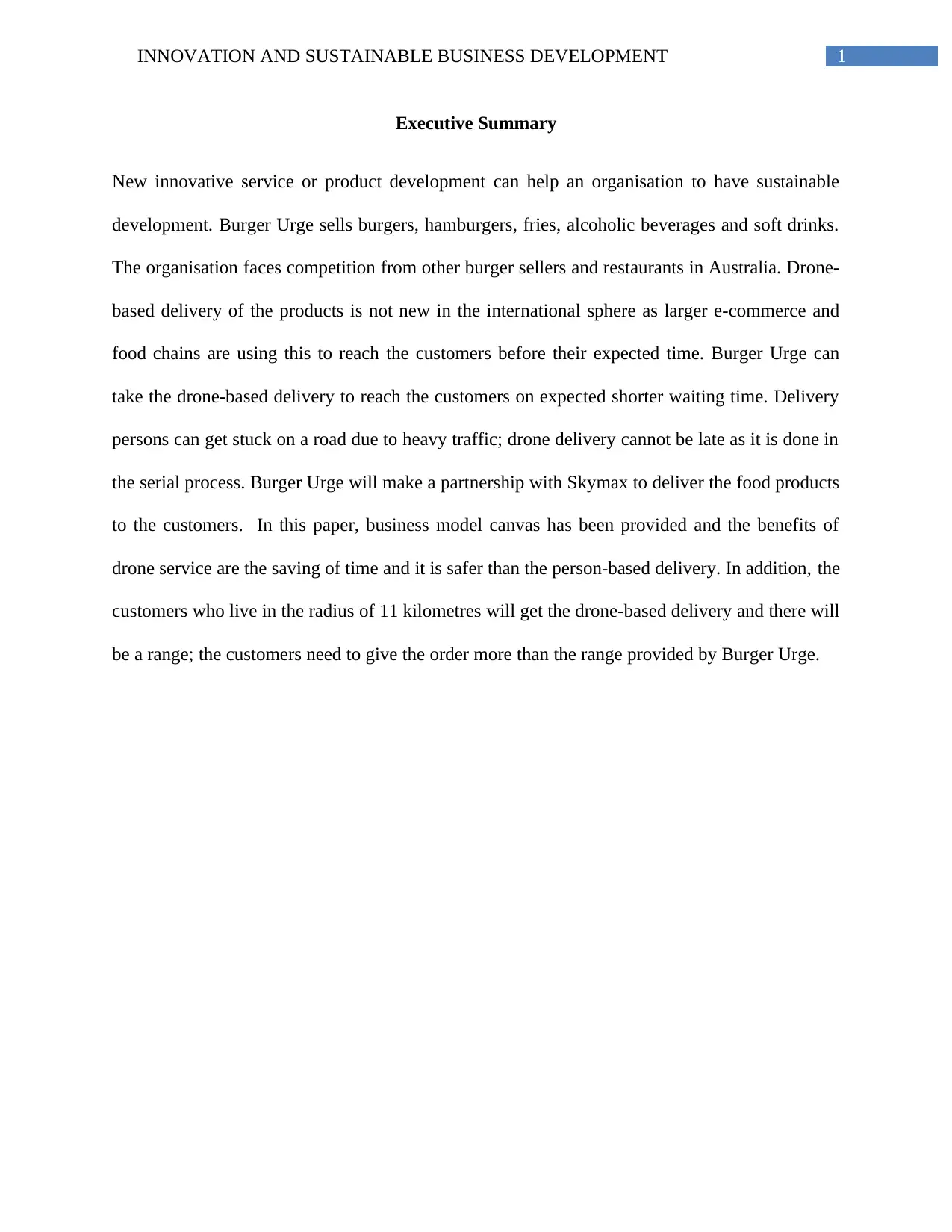
1INNOVATION AND SUSTAINABLE BUSINESS DEVELOPMENT
Executive Summary
New innovative service or product development can help an organisation to have sustainable
development. Burger Urge sells burgers, hamburgers, fries, alcoholic beverages and soft drinks.
The organisation faces competition from other burger sellers and restaurants in Australia. Drone-
based delivery of the products is not new in the international sphere as larger e-commerce and
food chains are using this to reach the customers before their expected time. Burger Urge can
take the drone-based delivery to reach the customers on expected shorter waiting time. Delivery
persons can get stuck on a road due to heavy traffic; drone delivery cannot be late as it is done in
the serial process. Burger Urge will make a partnership with Skymax to deliver the food products
to the customers. In this paper, business model canvas has been provided and the benefits of
drone service are the saving of time and it is safer than the person-based delivery. In addition, the
customers who live in the radius of 11 kilometres will get the drone-based delivery and there will
be a range; the customers need to give the order more than the range provided by Burger Urge.
Executive Summary
New innovative service or product development can help an organisation to have sustainable
development. Burger Urge sells burgers, hamburgers, fries, alcoholic beverages and soft drinks.
The organisation faces competition from other burger sellers and restaurants in Australia. Drone-
based delivery of the products is not new in the international sphere as larger e-commerce and
food chains are using this to reach the customers before their expected time. Burger Urge can
take the drone-based delivery to reach the customers on expected shorter waiting time. Delivery
persons can get stuck on a road due to heavy traffic; drone delivery cannot be late as it is done in
the serial process. Burger Urge will make a partnership with Skymax to deliver the food products
to the customers. In this paper, business model canvas has been provided and the benefits of
drone service are the saving of time and it is safer than the person-based delivery. In addition, the
customers who live in the radius of 11 kilometres will get the drone-based delivery and there will
be a range; the customers need to give the order more than the range provided by Burger Urge.
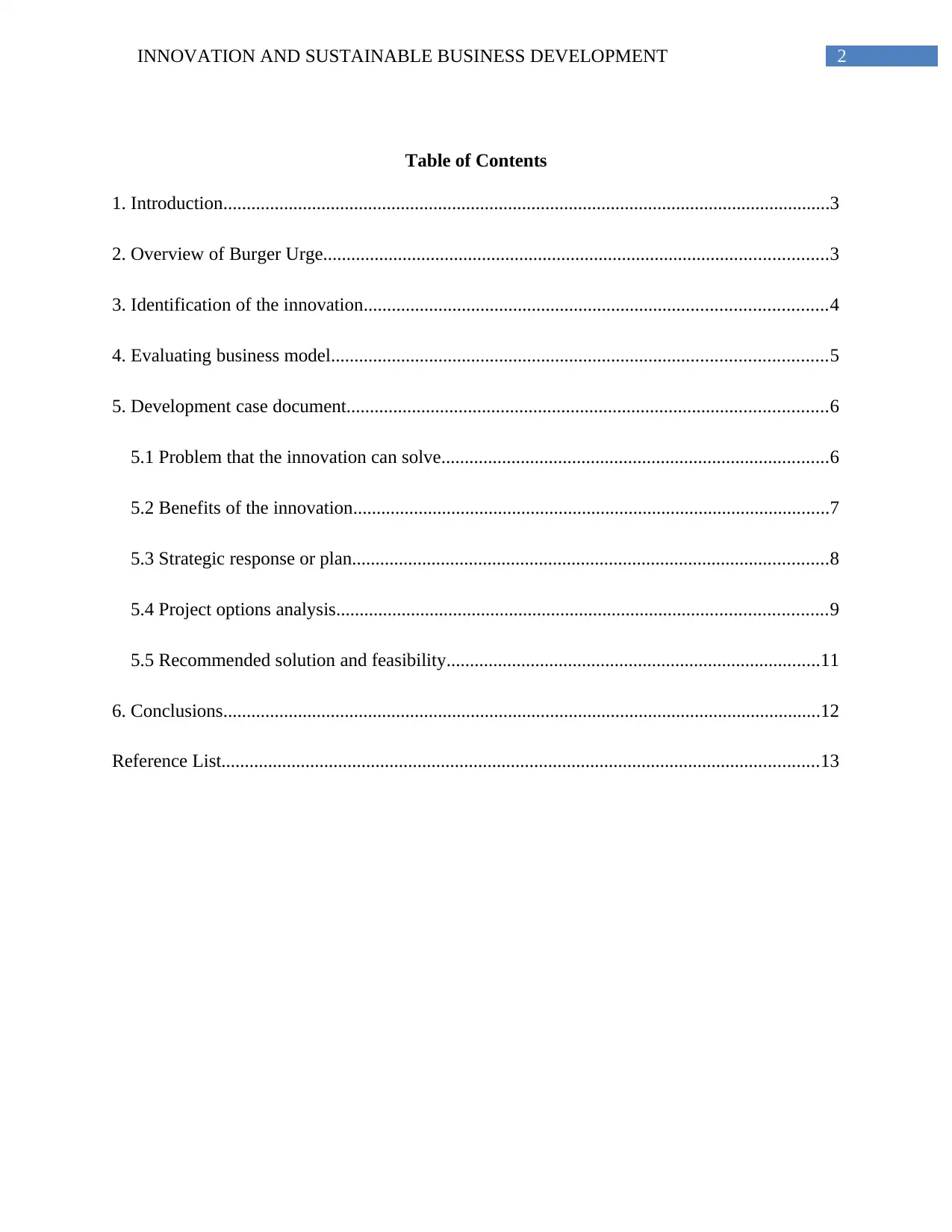
2INNOVATION AND SUSTAINABLE BUSINESS DEVELOPMENT
Table of Contents
1. Introduction..................................................................................................................................3
2. Overview of Burger Urge............................................................................................................3
3. Identification of the innovation...................................................................................................4
4. Evaluating business model..........................................................................................................5
5. Development case document.......................................................................................................6
5.1 Problem that the innovation can solve...................................................................................6
5.2 Benefits of the innovation......................................................................................................7
5.3 Strategic response or plan......................................................................................................8
5.4 Project options analysis.........................................................................................................9
5.5 Recommended solution and feasibility................................................................................11
6. Conclusions................................................................................................................................12
Reference List................................................................................................................................13
Table of Contents
1. Introduction..................................................................................................................................3
2. Overview of Burger Urge............................................................................................................3
3. Identification of the innovation...................................................................................................4
4. Evaluating business model..........................................................................................................5
5. Development case document.......................................................................................................6
5.1 Problem that the innovation can solve...................................................................................6
5.2 Benefits of the innovation......................................................................................................7
5.3 Strategic response or plan......................................................................................................8
5.4 Project options analysis.........................................................................................................9
5.5 Recommended solution and feasibility................................................................................11
6. Conclusions................................................................................................................................12
Reference List................................................................................................................................13
⊘ This is a preview!⊘
Do you want full access?
Subscribe today to unlock all pages.

Trusted by 1+ million students worldwide
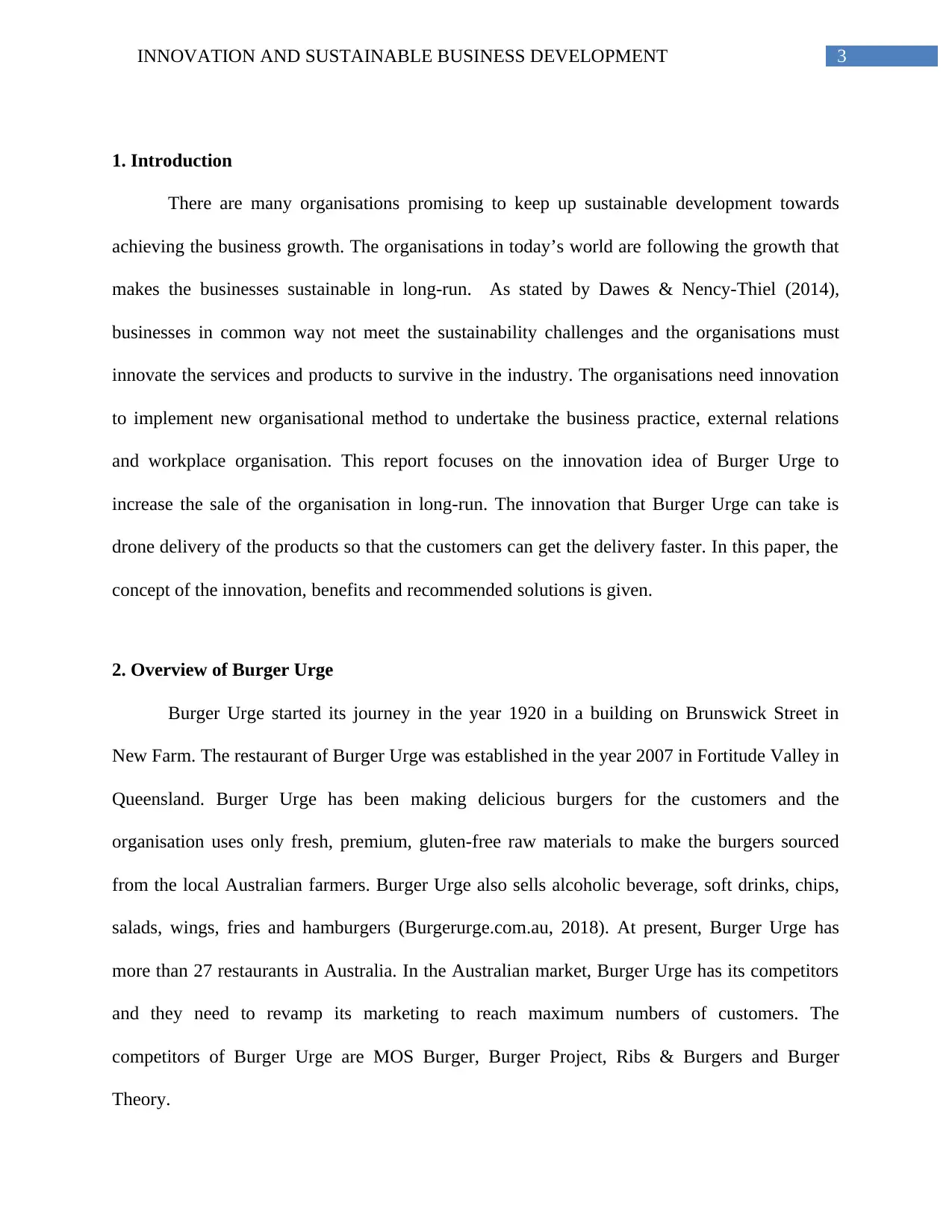
3INNOVATION AND SUSTAINABLE BUSINESS DEVELOPMENT
1. Introduction
There are many organisations promising to keep up sustainable development towards
achieving the business growth. The organisations in today’s world are following the growth that
makes the businesses sustainable in long-run. As stated by Dawes & Nency-Thiel (2014),
businesses in common way not meet the sustainability challenges and the organisations must
innovate the services and products to survive in the industry. The organisations need innovation
to implement new organisational method to undertake the business practice, external relations
and workplace organisation. This report focuses on the innovation idea of Burger Urge to
increase the sale of the organisation in long-run. The innovation that Burger Urge can take is
drone delivery of the products so that the customers can get the delivery faster. In this paper, the
concept of the innovation, benefits and recommended solutions is given.
2. Overview of Burger Urge
Burger Urge started its journey in the year 1920 in a building on Brunswick Street in
New Farm. The restaurant of Burger Urge was established in the year 2007 in Fortitude Valley in
Queensland. Burger Urge has been making delicious burgers for the customers and the
organisation uses only fresh, premium, gluten-free raw materials to make the burgers sourced
from the local Australian farmers. Burger Urge also sells alcoholic beverage, soft drinks, chips,
salads, wings, fries and hamburgers (Burgerurge.com.au, 2018). At present, Burger Urge has
more than 27 restaurants in Australia. In the Australian market, Burger Urge has its competitors
and they need to revamp its marketing to reach maximum numbers of customers. The
competitors of Burger Urge are MOS Burger, Burger Project, Ribs & Burgers and Burger
Theory.
1. Introduction
There are many organisations promising to keep up sustainable development towards
achieving the business growth. The organisations in today’s world are following the growth that
makes the businesses sustainable in long-run. As stated by Dawes & Nency-Thiel (2014),
businesses in common way not meet the sustainability challenges and the organisations must
innovate the services and products to survive in the industry. The organisations need innovation
to implement new organisational method to undertake the business practice, external relations
and workplace organisation. This report focuses on the innovation idea of Burger Urge to
increase the sale of the organisation in long-run. The innovation that Burger Urge can take is
drone delivery of the products so that the customers can get the delivery faster. In this paper, the
concept of the innovation, benefits and recommended solutions is given.
2. Overview of Burger Urge
Burger Urge started its journey in the year 1920 in a building on Brunswick Street in
New Farm. The restaurant of Burger Urge was established in the year 2007 in Fortitude Valley in
Queensland. Burger Urge has been making delicious burgers for the customers and the
organisation uses only fresh, premium, gluten-free raw materials to make the burgers sourced
from the local Australian farmers. Burger Urge also sells alcoholic beverage, soft drinks, chips,
salads, wings, fries and hamburgers (Burgerurge.com.au, 2018). At present, Burger Urge has
more than 27 restaurants in Australia. In the Australian market, Burger Urge has its competitors
and they need to revamp its marketing to reach maximum numbers of customers. The
competitors of Burger Urge are MOS Burger, Burger Project, Ribs & Burgers and Burger
Theory.
Paraphrase This Document
Need a fresh take? Get an instant paraphrase of this document with our AI Paraphraser
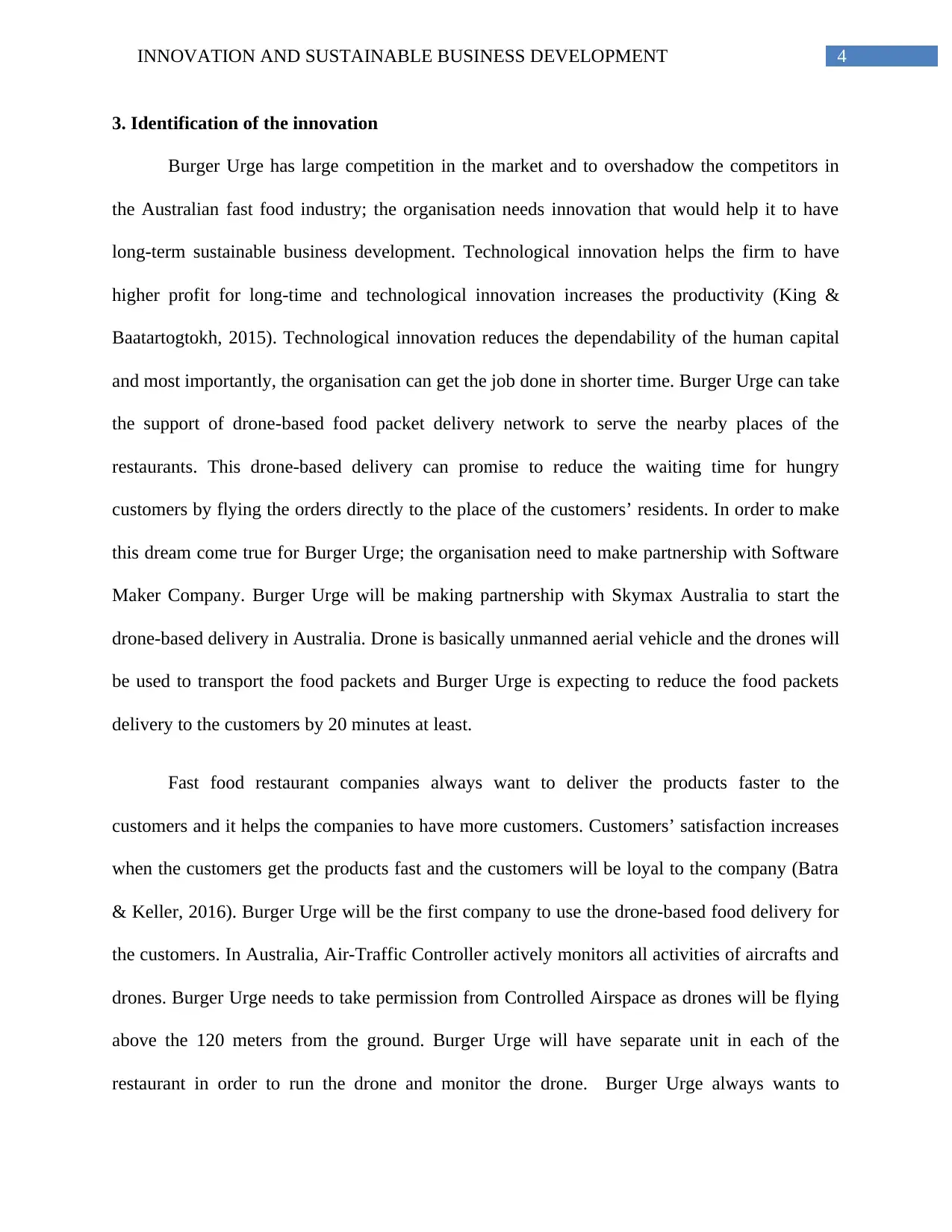
4INNOVATION AND SUSTAINABLE BUSINESS DEVELOPMENT
3. Identification of the innovation
Burger Urge has large competition in the market and to overshadow the competitors in
the Australian fast food industry; the organisation needs innovation that would help it to have
long-term sustainable business development. Technological innovation helps the firm to have
higher profit for long-time and technological innovation increases the productivity (King &
Baatartogtokh, 2015). Technological innovation reduces the dependability of the human capital
and most importantly, the organisation can get the job done in shorter time. Burger Urge can take
the support of drone-based food packet delivery network to serve the nearby places of the
restaurants. This drone-based delivery can promise to reduce the waiting time for hungry
customers by flying the orders directly to the place of the customers’ residents. In order to make
this dream come true for Burger Urge; the organisation need to make partnership with Software
Maker Company. Burger Urge will be making partnership with Skymax Australia to start the
drone-based delivery in Australia. Drone is basically unmanned aerial vehicle and the drones will
be used to transport the food packets and Burger Urge is expecting to reduce the food packets
delivery to the customers by 20 minutes at least.
Fast food restaurant companies always want to deliver the products faster to the
customers and it helps the companies to have more customers. Customers’ satisfaction increases
when the customers get the products fast and the customers will be loyal to the company (Batra
& Keller, 2016). Burger Urge will be the first company to use the drone-based food delivery for
the customers. In Australia, Air-Traffic Controller actively monitors all activities of aircrafts and
drones. Burger Urge needs to take permission from Controlled Airspace as drones will be flying
above the 120 meters from the ground. Burger Urge will have separate unit in each of the
restaurant in order to run the drone and monitor the drone. Burger Urge always wants to
3. Identification of the innovation
Burger Urge has large competition in the market and to overshadow the competitors in
the Australian fast food industry; the organisation needs innovation that would help it to have
long-term sustainable business development. Technological innovation helps the firm to have
higher profit for long-time and technological innovation increases the productivity (King &
Baatartogtokh, 2015). Technological innovation reduces the dependability of the human capital
and most importantly, the organisation can get the job done in shorter time. Burger Urge can take
the support of drone-based food packet delivery network to serve the nearby places of the
restaurants. This drone-based delivery can promise to reduce the waiting time for hungry
customers by flying the orders directly to the place of the customers’ residents. In order to make
this dream come true for Burger Urge; the organisation need to make partnership with Software
Maker Company. Burger Urge will be making partnership with Skymax Australia to start the
drone-based delivery in Australia. Drone is basically unmanned aerial vehicle and the drones will
be used to transport the food packets and Burger Urge is expecting to reduce the food packets
delivery to the customers by 20 minutes at least.
Fast food restaurant companies always want to deliver the products faster to the
customers and it helps the companies to have more customers. Customers’ satisfaction increases
when the customers get the products fast and the customers will be loyal to the company (Batra
& Keller, 2016). Burger Urge will be the first company to use the drone-based food delivery for
the customers. In Australia, Air-Traffic Controller actively monitors all activities of aircrafts and
drones. Burger Urge needs to take permission from Controlled Airspace as drones will be flying
above the 120 meters from the ground. Burger Urge will have separate unit in each of the
restaurant in order to run the drone and monitor the drone. Burger Urge always wants to
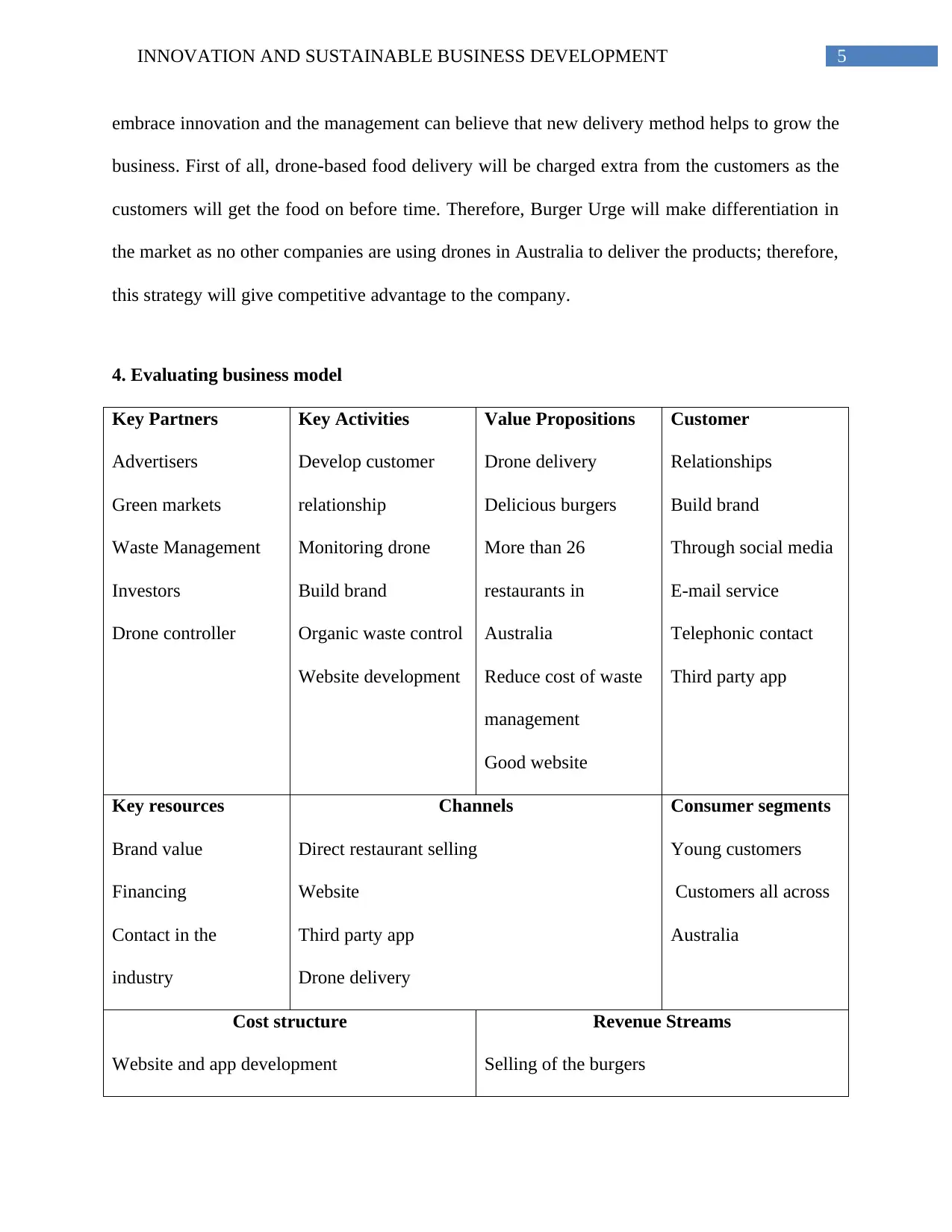
5INNOVATION AND SUSTAINABLE BUSINESS DEVELOPMENT
embrace innovation and the management can believe that new delivery method helps to grow the
business. First of all, drone-based food delivery will be charged extra from the customers as the
customers will get the food on before time. Therefore, Burger Urge will make differentiation in
the market as no other companies are using drones in Australia to deliver the products; therefore,
this strategy will give competitive advantage to the company.
4. Evaluating business model
Key Partners
Advertisers
Green markets
Waste Management
Investors
Drone controller
Key Activities
Develop customer
relationship
Monitoring drone
Build brand
Organic waste control
Website development
Value Propositions
Drone delivery
Delicious burgers
More than 26
restaurants in
Australia
Reduce cost of waste
management
Good website
Customer
Relationships
Build brand
Through social media
E-mail service
Telephonic contact
Third party app
Key resources
Brand value
Financing
Contact in the
industry
Channels
Direct restaurant selling
Website
Third party app
Drone delivery
Consumer segments
Young customers
Customers all across
Australia
Cost structure
Website and app development
Revenue Streams
Selling of the burgers
embrace innovation and the management can believe that new delivery method helps to grow the
business. First of all, drone-based food delivery will be charged extra from the customers as the
customers will get the food on before time. Therefore, Burger Urge will make differentiation in
the market as no other companies are using drones in Australia to deliver the products; therefore,
this strategy will give competitive advantage to the company.
4. Evaluating business model
Key Partners
Advertisers
Green markets
Waste Management
Investors
Drone controller
Key Activities
Develop customer
relationship
Monitoring drone
Build brand
Organic waste control
Website development
Value Propositions
Drone delivery
Delicious burgers
More than 26
restaurants in
Australia
Reduce cost of waste
management
Good website
Customer
Relationships
Build brand
Through social media
E-mail service
Telephonic contact
Third party app
Key resources
Brand value
Financing
Contact in the
industry
Channels
Direct restaurant selling
Website
Third party app
Drone delivery
Consumer segments
Young customers
Customers all across
Australia
Cost structure
Website and app development
Revenue Streams
Selling of the burgers
⊘ This is a preview!⊘
Do you want full access?
Subscribe today to unlock all pages.

Trusted by 1+ million students worldwide
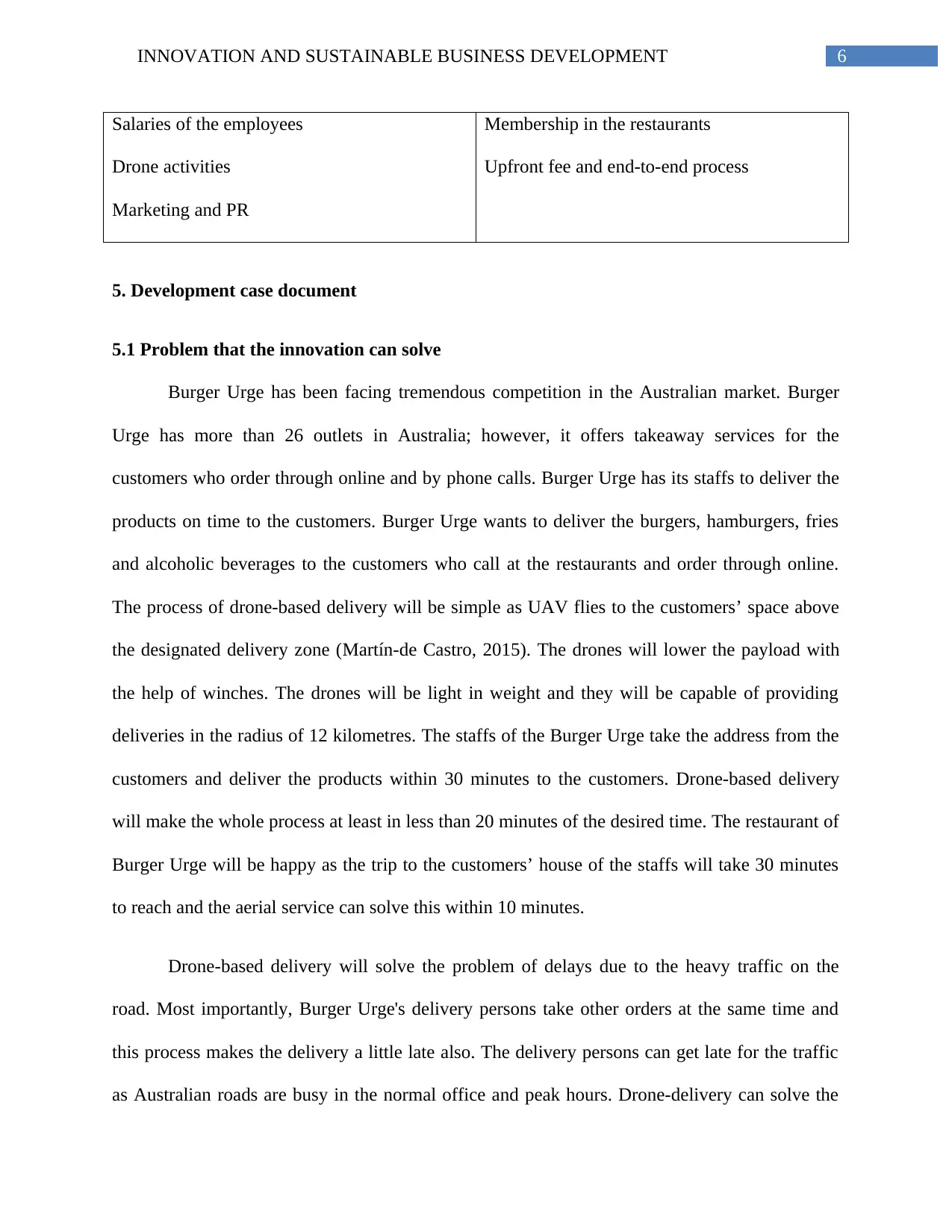
6INNOVATION AND SUSTAINABLE BUSINESS DEVELOPMENT
Salaries of the employees
Drone activities
Marketing and PR
Membership in the restaurants
Upfront fee and end-to-end process
5. Development case document
5.1 Problem that the innovation can solve
Burger Urge has been facing tremendous competition in the Australian market. Burger
Urge has more than 26 outlets in Australia; however, it offers takeaway services for the
customers who order through online and by phone calls. Burger Urge has its staffs to deliver the
products on time to the customers. Burger Urge wants to deliver the burgers, hamburgers, fries
and alcoholic beverages to the customers who call at the restaurants and order through online.
The process of drone-based delivery will be simple as UAV flies to the customers’ space above
the designated delivery zone (Martín-de Castro, 2015). The drones will lower the payload with
the help of winches. The drones will be light in weight and they will be capable of providing
deliveries in the radius of 12 kilometres. The staffs of the Burger Urge take the address from the
customers and deliver the products within 30 minutes to the customers. Drone-based delivery
will make the whole process at least in less than 20 minutes of the desired time. The restaurant of
Burger Urge will be happy as the trip to the customers’ house of the staffs will take 30 minutes
to reach and the aerial service can solve this within 10 minutes.
Drone-based delivery will solve the problem of delays due to the heavy traffic on the
road. Most importantly, Burger Urge's delivery persons take other orders at the same time and
this process makes the delivery a little late also. The delivery persons can get late for the traffic
as Australian roads are busy in the normal office and peak hours. Drone-delivery can solve the
Salaries of the employees
Drone activities
Marketing and PR
Membership in the restaurants
Upfront fee and end-to-end process
5. Development case document
5.1 Problem that the innovation can solve
Burger Urge has been facing tremendous competition in the Australian market. Burger
Urge has more than 26 outlets in Australia; however, it offers takeaway services for the
customers who order through online and by phone calls. Burger Urge has its staffs to deliver the
products on time to the customers. Burger Urge wants to deliver the burgers, hamburgers, fries
and alcoholic beverages to the customers who call at the restaurants and order through online.
The process of drone-based delivery will be simple as UAV flies to the customers’ space above
the designated delivery zone (Martín-de Castro, 2015). The drones will lower the payload with
the help of winches. The drones will be light in weight and they will be capable of providing
deliveries in the radius of 12 kilometres. The staffs of the Burger Urge take the address from the
customers and deliver the products within 30 minutes to the customers. Drone-based delivery
will make the whole process at least in less than 20 minutes of the desired time. The restaurant of
Burger Urge will be happy as the trip to the customers’ house of the staffs will take 30 minutes
to reach and the aerial service can solve this within 10 minutes.
Drone-based delivery will solve the problem of delays due to the heavy traffic on the
road. Most importantly, Burger Urge's delivery persons take other orders at the same time and
this process makes the delivery a little late also. The delivery persons can get late for the traffic
as Australian roads are busy in the normal office and peak hours. Drone-delivery can solve the
Paraphrase This Document
Need a fresh take? Get an instant paraphrase of this document with our AI Paraphraser
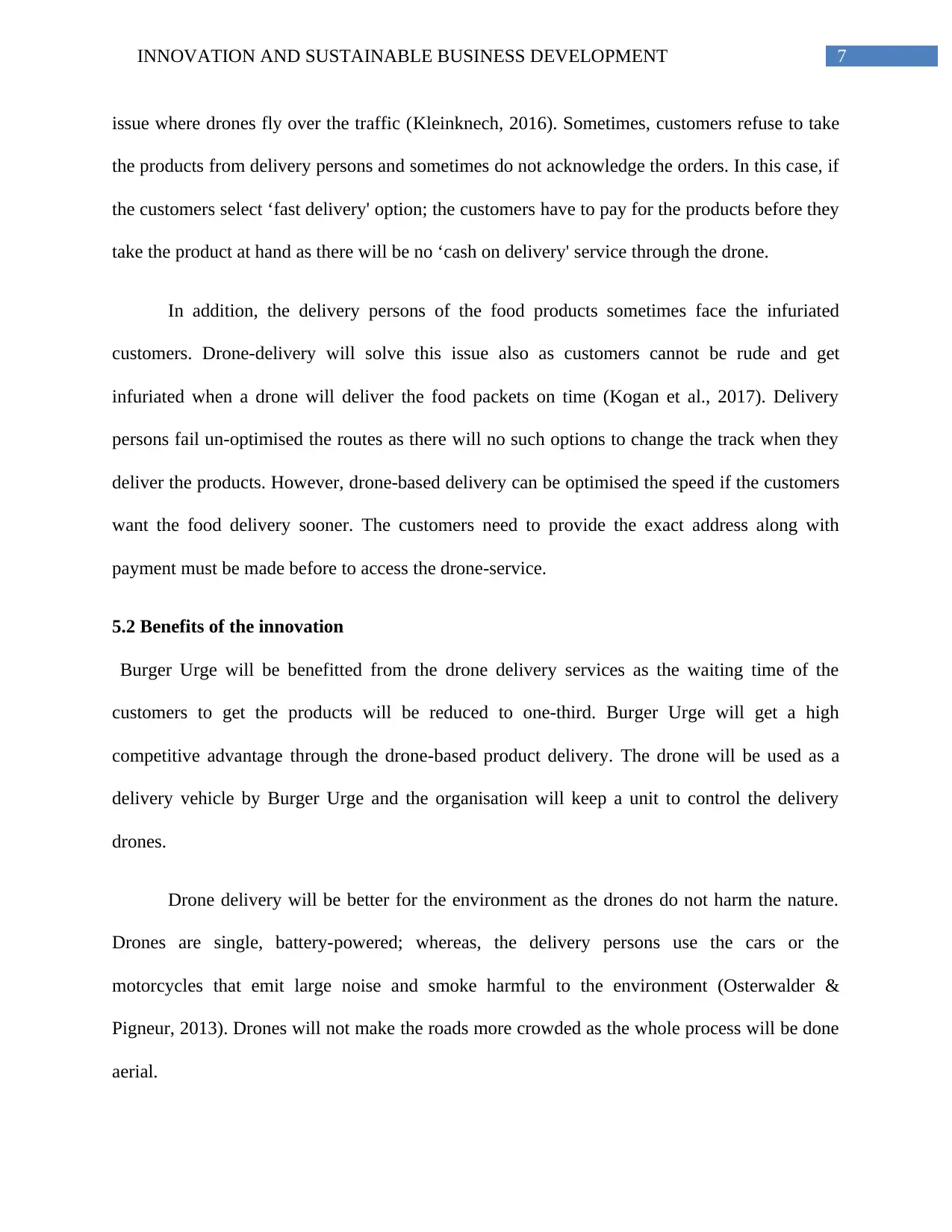
7INNOVATION AND SUSTAINABLE BUSINESS DEVELOPMENT
issue where drones fly over the traffic (Kleinknech, 2016). Sometimes, customers refuse to take
the products from delivery persons and sometimes do not acknowledge the orders. In this case, if
the customers select ‘fast delivery' option; the customers have to pay for the products before they
take the product at hand as there will be no ‘cash on delivery' service through the drone.
In addition, the delivery persons of the food products sometimes face the infuriated
customers. Drone-delivery will solve this issue also as customers cannot be rude and get
infuriated when a drone will deliver the food packets on time (Kogan et al., 2017). Delivery
persons fail un-optimised the routes as there will no such options to change the track when they
deliver the products. However, drone-based delivery can be optimised the speed if the customers
want the food delivery sooner. The customers need to provide the exact address along with
payment must be made before to access the drone-service.
5.2 Benefits of the innovation
Burger Urge will be benefitted from the drone delivery services as the waiting time of the
customers to get the products will be reduced to one-third. Burger Urge will get a high
competitive advantage through the drone-based product delivery. The drone will be used as a
delivery vehicle by Burger Urge and the organisation will keep a unit to control the delivery
drones.
Drone delivery will be better for the environment as the drones do not harm the nature.
Drones are single, battery-powered; whereas, the delivery persons use the cars or the
motorcycles that emit large noise and smoke harmful to the environment (Osterwalder &
Pigneur, 2013). Drones will not make the roads more crowded as the whole process will be done
aerial.
issue where drones fly over the traffic (Kleinknech, 2016). Sometimes, customers refuse to take
the products from delivery persons and sometimes do not acknowledge the orders. In this case, if
the customers select ‘fast delivery' option; the customers have to pay for the products before they
take the product at hand as there will be no ‘cash on delivery' service through the drone.
In addition, the delivery persons of the food products sometimes face the infuriated
customers. Drone-delivery will solve this issue also as customers cannot be rude and get
infuriated when a drone will deliver the food packets on time (Kogan et al., 2017). Delivery
persons fail un-optimised the routes as there will no such options to change the track when they
deliver the products. However, drone-based delivery can be optimised the speed if the customers
want the food delivery sooner. The customers need to provide the exact address along with
payment must be made before to access the drone-service.
5.2 Benefits of the innovation
Burger Urge will be benefitted from the drone delivery services as the waiting time of the
customers to get the products will be reduced to one-third. Burger Urge will get a high
competitive advantage through the drone-based product delivery. The drone will be used as a
delivery vehicle by Burger Urge and the organisation will keep a unit to control the delivery
drones.
Drone delivery will be better for the environment as the drones do not harm the nature.
Drones are single, battery-powered; whereas, the delivery persons use the cars or the
motorcycles that emit large noise and smoke harmful to the environment (Osterwalder &
Pigneur, 2013). Drones will not make the roads more crowded as the whole process will be done
aerial.
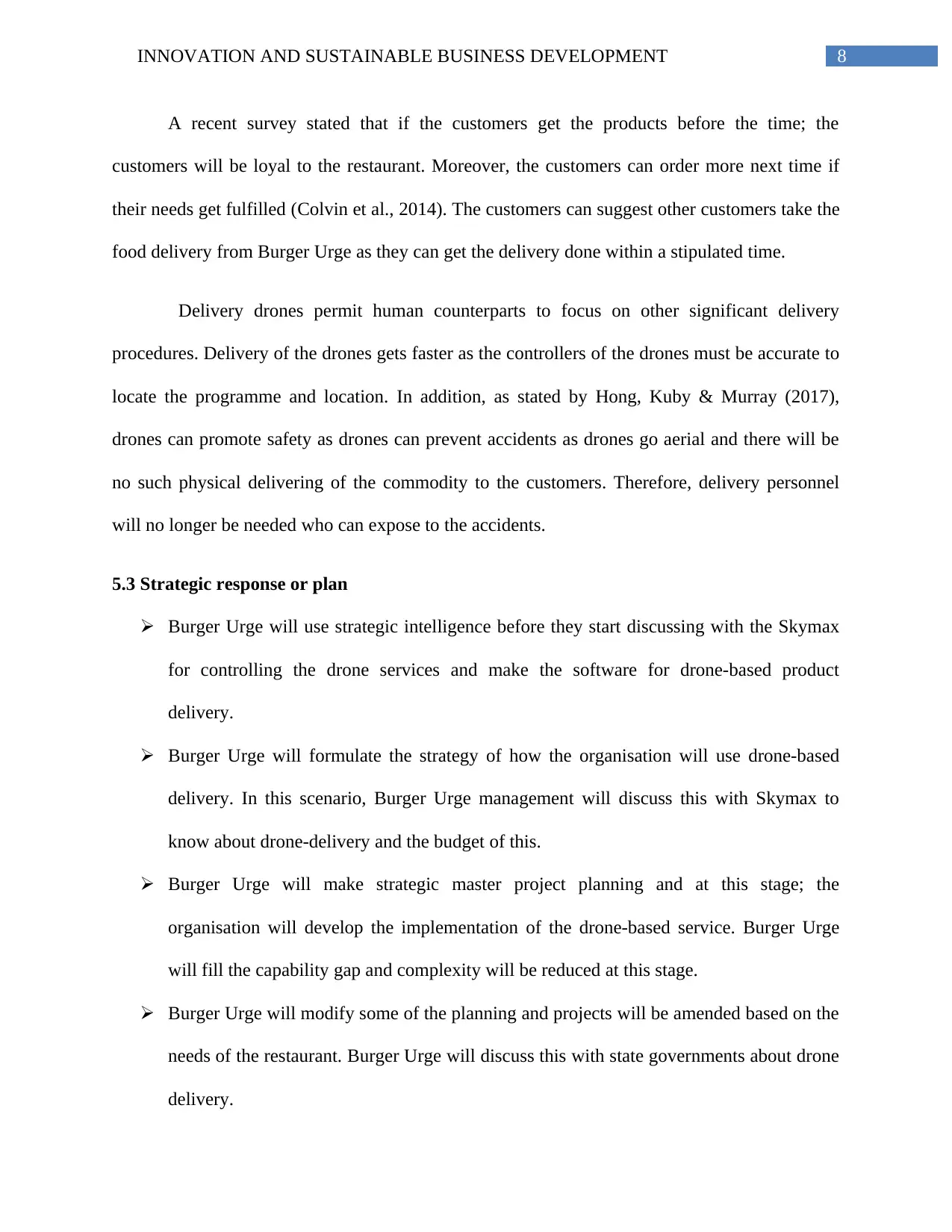
8INNOVATION AND SUSTAINABLE BUSINESS DEVELOPMENT
A recent survey stated that if the customers get the products before the time; the
customers will be loyal to the restaurant. Moreover, the customers can order more next time if
their needs get fulfilled (Colvin et al., 2014). The customers can suggest other customers take the
food delivery from Burger Urge as they can get the delivery done within a stipulated time.
Delivery drones permit human counterparts to focus on other significant delivery
procedures. Delivery of the drones gets faster as the controllers of the drones must be accurate to
locate the programme and location. In addition, as stated by Hong, Kuby & Murray (2017),
drones can promote safety as drones can prevent accidents as drones go aerial and there will be
no such physical delivering of the commodity to the customers. Therefore, delivery personnel
will no longer be needed who can expose to the accidents.
5.3 Strategic response or plan
Burger Urge will use strategic intelligence before they start discussing with the Skymax
for controlling the drone services and make the software for drone-based product
delivery.
Burger Urge will formulate the strategy of how the organisation will use drone-based
delivery. In this scenario, Burger Urge management will discuss this with Skymax to
know about drone-delivery and the budget of this.
Burger Urge will make strategic master project planning and at this stage; the
organisation will develop the implementation of the drone-based service. Burger Urge
will fill the capability gap and complexity will be reduced at this stage.
Burger Urge will modify some of the planning and projects will be amended based on the
needs of the restaurant. Burger Urge will discuss this with state governments about drone
delivery.
A recent survey stated that if the customers get the products before the time; the
customers will be loyal to the restaurant. Moreover, the customers can order more next time if
their needs get fulfilled (Colvin et al., 2014). The customers can suggest other customers take the
food delivery from Burger Urge as they can get the delivery done within a stipulated time.
Delivery drones permit human counterparts to focus on other significant delivery
procedures. Delivery of the drones gets faster as the controllers of the drones must be accurate to
locate the programme and location. In addition, as stated by Hong, Kuby & Murray (2017),
drones can promote safety as drones can prevent accidents as drones go aerial and there will be
no such physical delivering of the commodity to the customers. Therefore, delivery personnel
will no longer be needed who can expose to the accidents.
5.3 Strategic response or plan
Burger Urge will use strategic intelligence before they start discussing with the Skymax
for controlling the drone services and make the software for drone-based product
delivery.
Burger Urge will formulate the strategy of how the organisation will use drone-based
delivery. In this scenario, Burger Urge management will discuss this with Skymax to
know about drone-delivery and the budget of this.
Burger Urge will make strategic master project planning and at this stage; the
organisation will develop the implementation of the drone-based service. Burger Urge
will fill the capability gap and complexity will be reduced at this stage.
Burger Urge will modify some of the planning and projects will be amended based on the
needs of the restaurant. Burger Urge will discuss this with state governments about drone
delivery.
⊘ This is a preview!⊘
Do you want full access?
Subscribe today to unlock all pages.

Trusted by 1+ million students worldwide
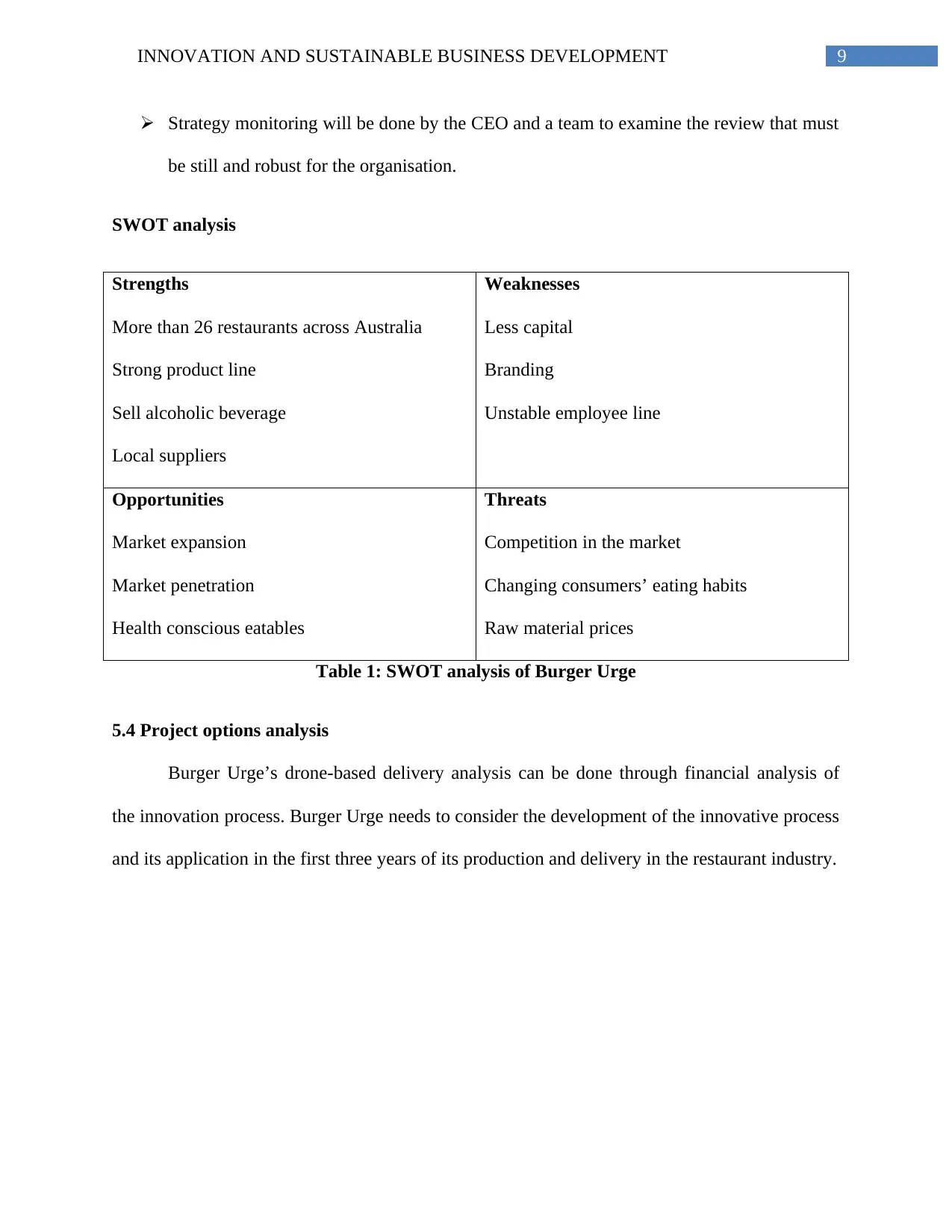
9INNOVATION AND SUSTAINABLE BUSINESS DEVELOPMENT
Strategy monitoring will be done by the CEO and a team to examine the review that must
be still and robust for the organisation.
SWOT analysis
Strengths
More than 26 restaurants across Australia
Strong product line
Sell alcoholic beverage
Local suppliers
Weaknesses
Less capital
Branding
Unstable employee line
Opportunities
Market expansion
Market penetration
Health conscious eatables
Threats
Competition in the market
Changing consumers’ eating habits
Raw material prices
Table 1: SWOT analysis of Burger Urge
5.4 Project options analysis
Burger Urge’s drone-based delivery analysis can be done through financial analysis of
the innovation process. Burger Urge needs to consider the development of the innovative process
and its application in the first three years of its production and delivery in the restaurant industry.
Strategy monitoring will be done by the CEO and a team to examine the review that must
be still and robust for the organisation.
SWOT analysis
Strengths
More than 26 restaurants across Australia
Strong product line
Sell alcoholic beverage
Local suppliers
Weaknesses
Less capital
Branding
Unstable employee line
Opportunities
Market expansion
Market penetration
Health conscious eatables
Threats
Competition in the market
Changing consumers’ eating habits
Raw material prices
Table 1: SWOT analysis of Burger Urge
5.4 Project options analysis
Burger Urge’s drone-based delivery analysis can be done through financial analysis of
the innovation process. Burger Urge needs to consider the development of the innovative process
and its application in the first three years of its production and delivery in the restaurant industry.
Paraphrase This Document
Need a fresh take? Get an instant paraphrase of this document with our AI Paraphraser
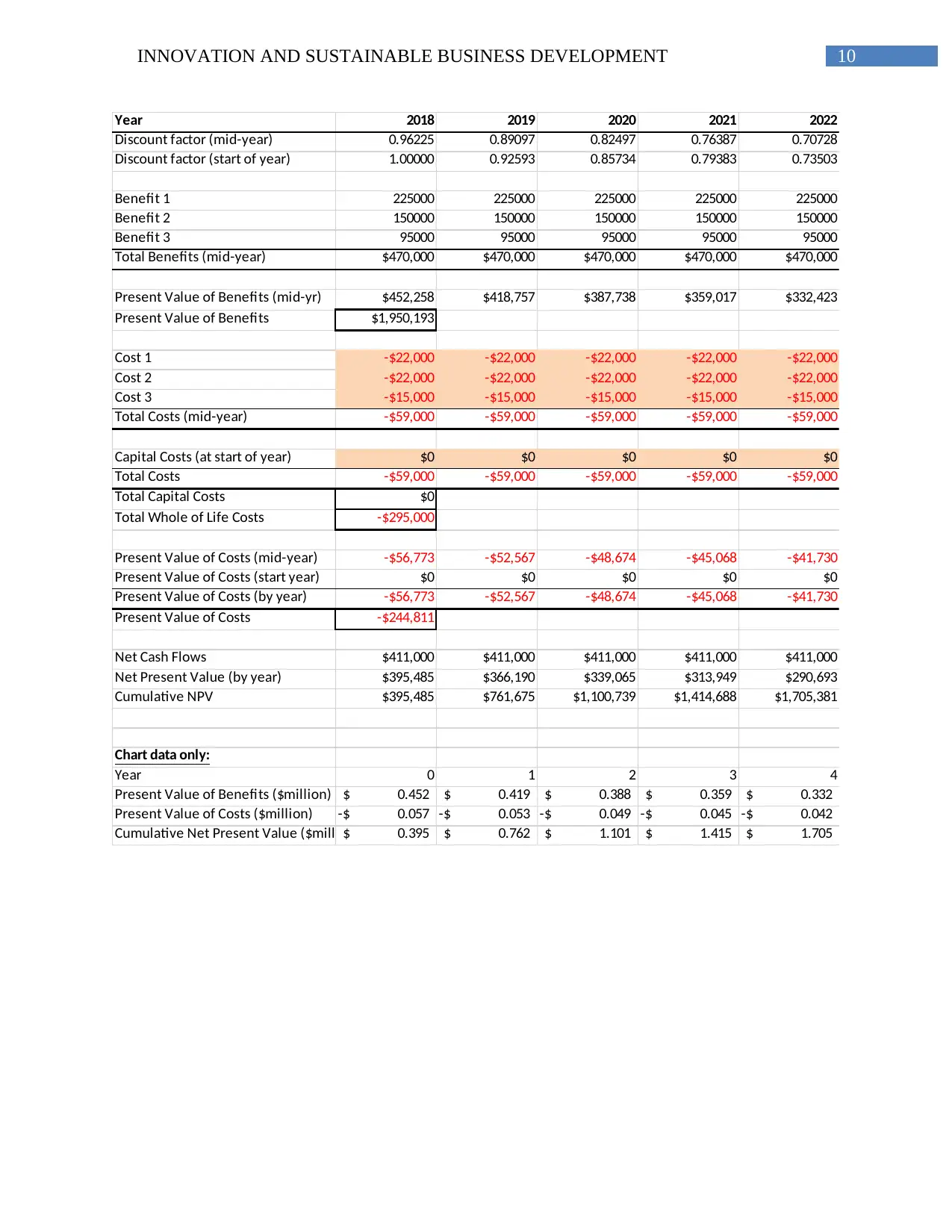
10INNOVATION AND SUSTAINABLE BUSINESS DEVELOPMENT
Year 2018 2019 2020 2021 2022
Discount factor (mid-year) 0.96225 0.89097 0.82497 0.76387 0.70728
Discount factor (start of year) 1.00000 0.92593 0.85734 0.79383 0.73503
Benefit 1 225000 225000 225000 225000 225000
Benefit 2 150000 150000 150000 150000 150000
Benefit 3 95000 95000 95000 95000 95000
Total Benefits (mid-year) $470,000 $470,000 $470,000 $470,000 $470,000
Present Value of Benefits (mid-yr) $452,258 $418,757 $387,738 $359,017 $332,423
Present Value of Benefits $1,950,193
Cost 1 -$22,000 -$22,000 -$22,000 -$22,000 -$22,000
Cost 2 -$22,000 -$22,000 -$22,000 -$22,000 -$22,000
Cost 3 -$15,000 -$15,000 -$15,000 -$15,000 -$15,000
Total Costs (mid-year) -$59,000 -$59,000 -$59,000 -$59,000 -$59,000
Capital Costs (at start of year) $0 $0 $0 $0 $0
Total Costs -$59,000 -$59,000 -$59,000 -$59,000 -$59,000
Total Capital Costs $0
Total Whole of Life Costs -$295,000
Present Value of Costs (mid-year) -$56,773 -$52,567 -$48,674 -$45,068 -$41,730
Present Value of Costs (start year) $0 $0 $0 $0 $0
Present Value of Costs (by year) -$56,773 -$52,567 -$48,674 -$45,068 -$41,730
Present Value of Costs -$244,811
Net Cash Flows $411,000 $411,000 $411,000 $411,000 $411,000
Net Present Value (by year) $395,485 $366,190 $339,065 $313,949 $290,693
Cumulative NPV $395,485 $761,675 $1,100,739 $1,414,688 $1,705,381
Chart data only:
Year 0 1 2 3 4
Present Value of Benefits ($million) 0.452$ 0.419$ 0.388$ 0.359$ 0.332$
Present Value of Costs ($million) 0.057-$ 0.053-$ 0.049-$ 0.045-$ 0.042-$
Cumulative Net Present Value ($million) 0.395$ 0.762$ 1.101$ 1.415$ 1.705$
Year 2018 2019 2020 2021 2022
Discount factor (mid-year) 0.96225 0.89097 0.82497 0.76387 0.70728
Discount factor (start of year) 1.00000 0.92593 0.85734 0.79383 0.73503
Benefit 1 225000 225000 225000 225000 225000
Benefit 2 150000 150000 150000 150000 150000
Benefit 3 95000 95000 95000 95000 95000
Total Benefits (mid-year) $470,000 $470,000 $470,000 $470,000 $470,000
Present Value of Benefits (mid-yr) $452,258 $418,757 $387,738 $359,017 $332,423
Present Value of Benefits $1,950,193
Cost 1 -$22,000 -$22,000 -$22,000 -$22,000 -$22,000
Cost 2 -$22,000 -$22,000 -$22,000 -$22,000 -$22,000
Cost 3 -$15,000 -$15,000 -$15,000 -$15,000 -$15,000
Total Costs (mid-year) -$59,000 -$59,000 -$59,000 -$59,000 -$59,000
Capital Costs (at start of year) $0 $0 $0 $0 $0
Total Costs -$59,000 -$59,000 -$59,000 -$59,000 -$59,000
Total Capital Costs $0
Total Whole of Life Costs -$295,000
Present Value of Costs (mid-year) -$56,773 -$52,567 -$48,674 -$45,068 -$41,730
Present Value of Costs (start year) $0 $0 $0 $0 $0
Present Value of Costs (by year) -$56,773 -$52,567 -$48,674 -$45,068 -$41,730
Present Value of Costs -$244,811
Net Cash Flows $411,000 $411,000 $411,000 $411,000 $411,000
Net Present Value (by year) $395,485 $366,190 $339,065 $313,949 $290,693
Cumulative NPV $395,485 $761,675 $1,100,739 $1,414,688 $1,705,381
Chart data only:
Year 0 1 2 3 4
Present Value of Benefits ($million) 0.452$ 0.419$ 0.388$ 0.359$ 0.332$
Present Value of Costs ($million) 0.057-$ 0.053-$ 0.049-$ 0.045-$ 0.042-$
Cumulative Net Present Value ($million) 0.395$ 0.762$ 1.101$ 1.415$ 1.705$
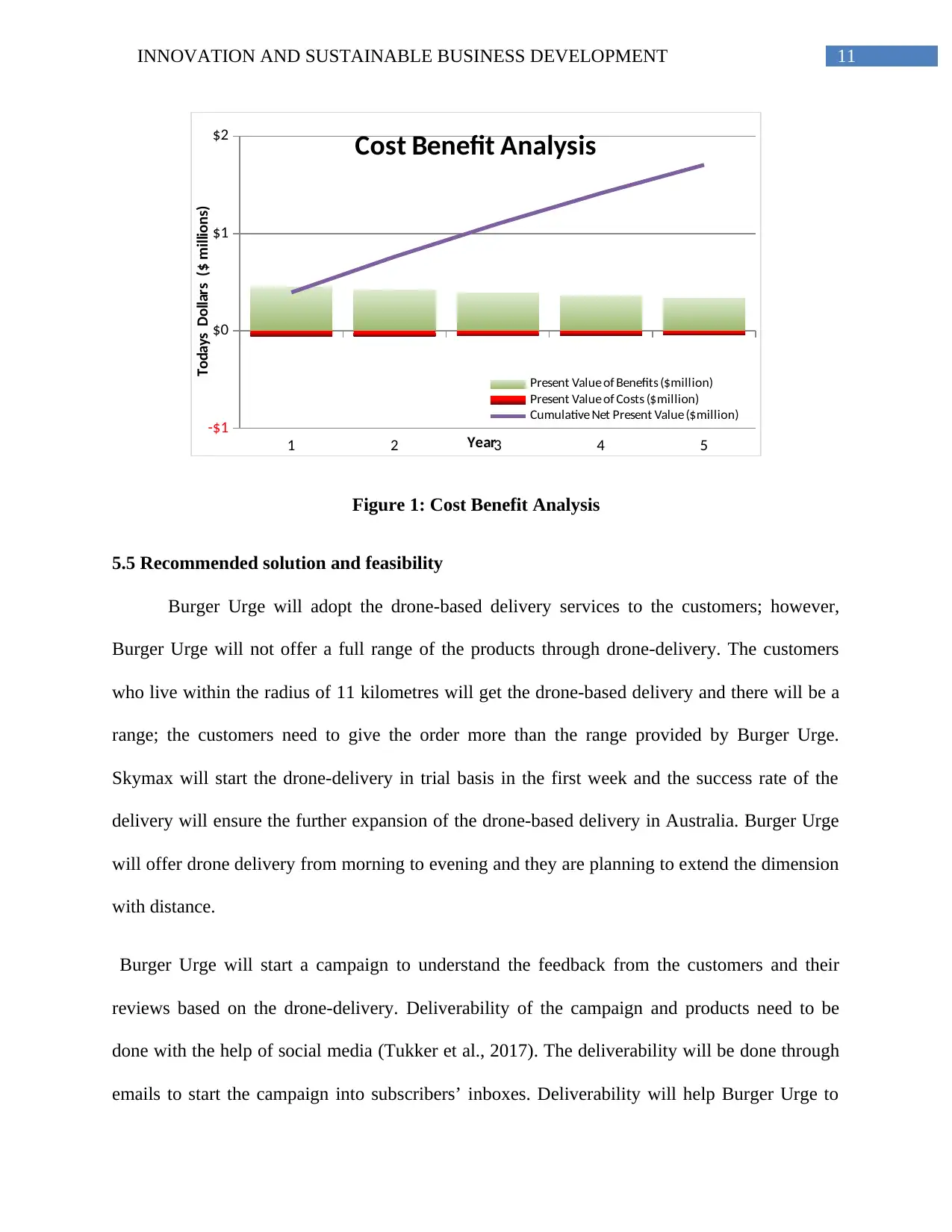
11INNOVATION AND SUSTAINABLE BUSINESS DEVELOPMENT
1 2 3 4 5
-$1
$0
$1
$2 Cost Benefit Analysis
Present Value of Benefits ($million)
Present Value of Costs ($million)
Cumulative Net Present Value ($million)
Year
Todays Dollars ($ millions)
Figure 1: Cost Benefit Analysis
5.5 Recommended solution and feasibility
Burger Urge will adopt the drone-based delivery services to the customers; however,
Burger Urge will not offer a full range of the products through drone-delivery. The customers
who live within the radius of 11 kilometres will get the drone-based delivery and there will be a
range; the customers need to give the order more than the range provided by Burger Urge.
Skymax will start the drone-delivery in trial basis in the first week and the success rate of the
delivery will ensure the further expansion of the drone-based delivery in Australia. Burger Urge
will offer drone delivery from morning to evening and they are planning to extend the dimension
with distance.
Burger Urge will start a campaign to understand the feedback from the customers and their
reviews based on the drone-delivery. Deliverability of the campaign and products need to be
done with the help of social media (Tukker et al., 2017). The deliverability will be done through
emails to start the campaign into subscribers’ inboxes. Deliverability will help Burger Urge to
1 2 3 4 5
-$1
$0
$1
$2 Cost Benefit Analysis
Present Value of Benefits ($million)
Present Value of Costs ($million)
Cumulative Net Present Value ($million)
Year
Todays Dollars ($ millions)
Figure 1: Cost Benefit Analysis
5.5 Recommended solution and feasibility
Burger Urge will adopt the drone-based delivery services to the customers; however,
Burger Urge will not offer a full range of the products through drone-delivery. The customers
who live within the radius of 11 kilometres will get the drone-based delivery and there will be a
range; the customers need to give the order more than the range provided by Burger Urge.
Skymax will start the drone-delivery in trial basis in the first week and the success rate of the
delivery will ensure the further expansion of the drone-based delivery in Australia. Burger Urge
will offer drone delivery from morning to evening and they are planning to extend the dimension
with distance.
Burger Urge will start a campaign to understand the feedback from the customers and their
reviews based on the drone-delivery. Deliverability of the campaign and products need to be
done with the help of social media (Tukker et al., 2017). The deliverability will be done through
emails to start the campaign into subscribers’ inboxes. Deliverability will help Burger Urge to
⊘ This is a preview!⊘
Do you want full access?
Subscribe today to unlock all pages.

Trusted by 1+ million students worldwide
1 out of 16
Related Documents
Your All-in-One AI-Powered Toolkit for Academic Success.
+13062052269
info@desklib.com
Available 24*7 on WhatsApp / Email
![[object Object]](/_next/static/media/star-bottom.7253800d.svg)
Unlock your academic potential
Copyright © 2020–2025 A2Z Services. All Rights Reserved. Developed and managed by ZUCOL.




